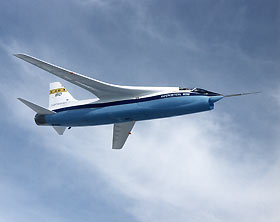
Enregistrez gratuitement cette image
en 800 pixels pour usage maquette
(click droit, Enregistrer l'image sous...)
|
|
Réf : S04140
Thème :
Aviation - Avions NASA-Prototypes (1538 images)
Titre : F-8 SCW in flight
Description : (La description de cette image n'existe qu'en anglais)
A Vought F-8A Crusader was selected by NASA as the testbed aircraft (designated TF-8A) to install an experimental Supercritical Wing in place of the conventional wing. The unique design of the Supercritical Wing (SCW) reduces the effect of shock waves on the upper surface near Mach 1, which in turn reduces drag.In this photograph a Vought F-8A Crusader is shown being used as a flying testbed for an experimental Supercritical Wing airfoil. The smooth fairing of the fiberglass glove with the wing is illustrated in this view. This is the configuration of the F-8 SCW aircraft late in the program. The SCW team fitted the fuselage with bulges fore and aft of the wings. This was similar to the proposed shape of a near-sonic airliner. Both the SCW airfoil and the bulged-fuselage design were optimal for cruise at Mach 0.98. Dr. Whitcomb (designer of the SCW) had previously spent about four years working on supersonic transport designs. He concluded that these were impractical due to their high operating costs. The high drag at speeds above Mach 1 resulted in greatly increased costs. Following the fuel-price rises caused by the October 1973 oil embargo, airlines lost interest in near-sonic transports. Rather, they wanted a design that would have lower fuel consumption. Dr. Whitcomb developed a modified supercritical-wing shape that provided higher lift-to-drag ratios at the same speeds. He did this by using thicker airfoil sections and a reduced wing sweepback. This resulted in an increased aspect ratio without an increase in wing weight. In the three decades since the F-8 SCW flew, the use of such airfoils has become common.
|
|

